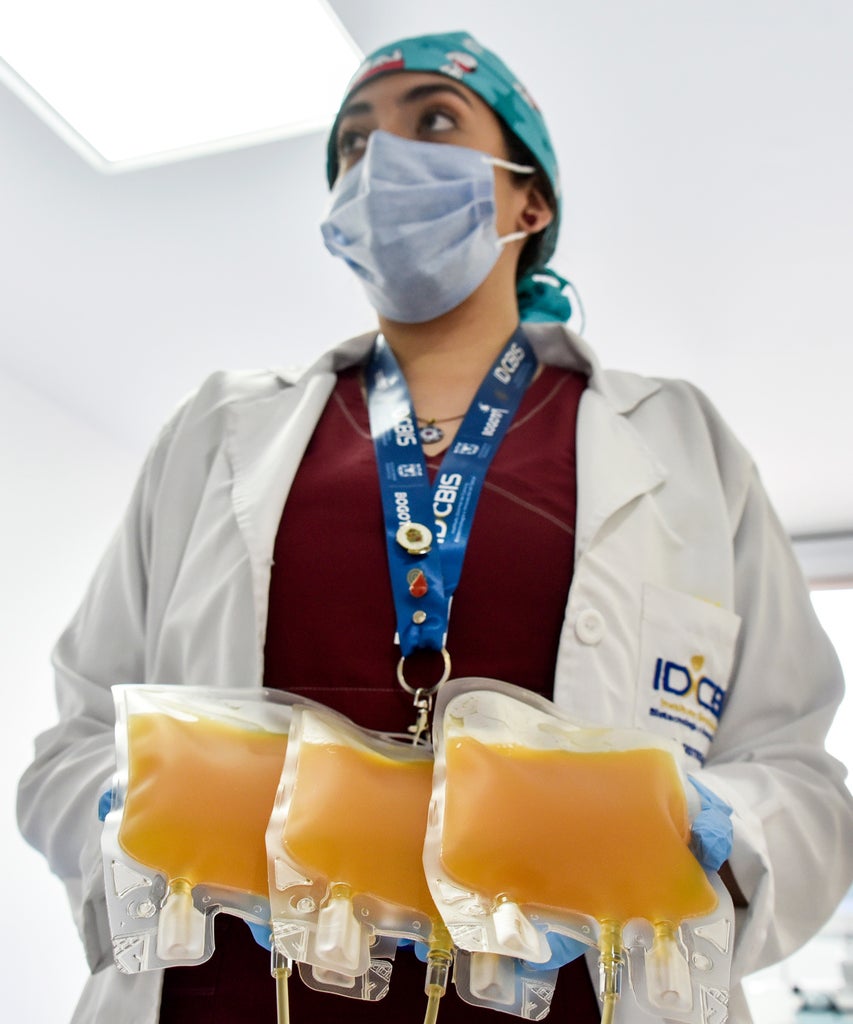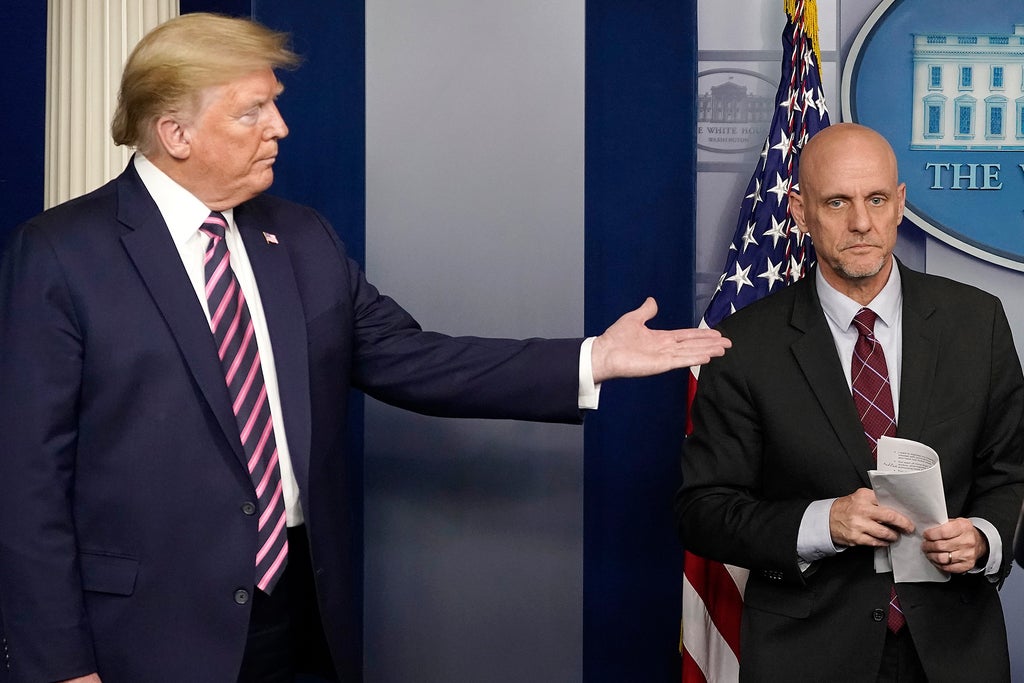
The Food and Drug Administration is giving emergency approval for a blood plasma treatment that may help hospitalized coronavirus patients. But in the 24 hours after the announcement, the decision was embroiled in controversy. The crux of the issue: Was convalescent plasma treatment really effective enough to warrant a EUA?
President Donald Trump called the protocol a “breakthrough” in a press conference on Sunday, August 23. On the other side were health experts who argued, “No one is sure whether convalescent plasma works.” In the middle were those saying convalescent plasma “shows promise” as a treatment for the virus, but more research need to be done.
The science behind the treatment, the safety of EUAs in general, and the possible political pressure that went into securing the emergency order are all strands in a spider’s web of reasons health experts are critiquing the FDA’s decision. There’s a lot to untangle, so let’s get to it.
The supposed cure
Plasma is a component of blood. Convalescent plasma refers to the stuff that’s taken from the blood of people who have recovered from COVID-19 and developed antibodies. That plasma is extracted (via a spin in a centrifuge that removes red and white blood cells) and given to people who are sick with the virus, via an IV. The idea is that the distilled antibodies in the plasma will help the ill person fight off the virus, explains Shmuel Shoham, MD, an associate professor of medicine at Johns Hopkins Medicine who’s currently working on study looking into COVID-19 and convalescent plasma. This protocol had already been used to help 97,319 patients as of August 17 as part of a nationwide “expanded access” program, Wired reports. Dozens of clinical trials into the treatment’s efficacy are underway, and so far they indicate some success when plasma with high antibody levels is injected into patients under 80 who aren’t on a ventilator within three days of diagnosis.
Despite the attention this potential remedy is getting, there are no drugs, treatments, or vaccines that have been officially and formally approved to treat COVID-19. But convalescent plasma was granted an emergency-use authorization. This means that the FDA has lowered its standards for approval in order to allow the treatment to be used right now, due to the emergency medical situation that is COVID-19.
The mysterious 35%
Trump and FDA officials are receiving heat for how they presented facts in a press conference when they announced the decision to grant an EUA. Critics said they “grossly misrepresented” the data when referring to a suspect statistic: that convalescent plasma reduced COVID-19 deaths by 35%. Trump, Health and Human Services Secretary Alex M. Azar II, and FDA Commissioner Stephen M. Hahn, MD, all referenced that number, The New York Times reports. But even one of the authors of the unpublished Mayo Clinic study that the officials were citing didn’t know where it came from.

Following the announcement, scientists gleaned that this figure was calculated based on a tiny subgroup of COVID-19 patients in the Mayo Clinic study. Those patients were hospitalized due to the coronavirus, younger than 80, not on ventilators, and received plasma with high levels of immune-boosting antibodies within three days of diagnosis — a very specific subset.
By 9 p.m. Monday night, Dr. Hahn conceded the criticism he received for his explanation of the benefits convalescent plasma data was “entirely justified.” “What I should have said better is that the data show a relative risk reduction, not an absolute risk reduction,” he tweeted.
I have been criticized for remarks I made Sunday night about the benefits of convalescent plasma. The criticism is entirely justified. What I should have said better is that the data show a relative risk reduction not an absolute risk reduction.
— Dr. Stephen M. Hahn (@SteveFDA) August 25, 2020
On Tuesday morning, he further clarified his position in an interview with CBS This Morning. He said that the FDA looked at Mayo Clinic data, comparing patients who got high concentrations of antibodies versus those who got low concentrations of antibodies. “When you look at those data, the survival benefits between those two groups, there’s a relative benefit of 35 percent,” he said. “And as I mentioned, I could have done a better job of explaining that at the press conference.”
The political pressure
Some pundits and health experts speculate that the timing of the EUA was politically motivated. The day before the decision was made, Trump tweeted: “The deep state, or whoever, over at the FDA is making it very difficult for drug companies to get people in order to test the vaccines and therapeutics. Obviously, they are hoping to delay the answer until after November 3rd. Must focus on speed, and saving lives!” He tagged Dr. Hahn.
The deep state, or whoever, over at the FDA is making it very difficult for drug companies to get people in order to test the vaccines and therapeutics. Obviously, they are hoping to delay the answer until after November 3rd. Must focus on speed, and saving lives! @SteveFDA
— Donald J. Trump (@realDonaldTrump) August 22, 2020
The EUA decision was made on the eve of the Republican National Convention, on August 23. The prior week, top scientists such as Anthony Fauci, MD, argued the data was too weak, temporarily halting the EUA designation. CNN called Trump’s EUA announcement an “attempt to jump-start” the RNC. Seemingly in response to the blowback, Hahn tweeted: “We at FDA do not permit politics to enter into our scientific decisions. This happens to be a political season but FDA will remain data driven”
When asked for comment, the FDA pointed Refinery29 to Dr. Hahn’s Tuesday morning interview with CBS. In conversation with Gayle King, he said the timing shook out the way it did because the FDA received pertinent additional data last week and this weekend. Once they had it, the ball could start rolling. “We’ve had some back and forth with external stakeholders, folks at the NIH, but also internally about what data we needed to see to justify an emergency use authorization,” he said.
The National Institutes of Health told Refinery29 in a statement: “The Food and Drug Administration has the sole authority to make Emergency Use Authorization decisions… The NIH will continue to focus on randomized clinical trials of convalescent plasma and other promising approaches to develop information to help inform the treatment of patients with coronavirus disease 2019.”
The case against EUAs
EUAs in general are often criticized. Deciding to grant emergency or “compassionate” approvals is a big deal, because “regulators must seek to strike a good balance in granting as wide therapeutic access to new drugs as possible at the same time as gathering sound evidence of safety and effectiveness,” as an article in The Journal of American Bioethics noted. The determination can also lead doctors to “panic prescribe” treatments, as Arthur Caplan, PhD, wrote in an opinion column for Stat News.
During the pandemic, the FDA has granted a handful of EUAs, including one recently for a saliva test. In June, the organization revoked its EUA for hydroxychloroquine, an antimalarial drug which was initially lauded by Trump as helpful in the fight against COVID-19. The drug’s “potential benefits for such use do not outweigh its known and potential risks,” said Rear Admiral Denise Hinton, the FDA’s chief scientist, in a letter dismantling the EUA in June.
Anther issue: “Emergency use is usually not covered by third-party payers,” Caplan, a professor of bioethics and the founding head of New York University School of Medicine’s Division of Medical Ethics, writes. “So, the rich will likely be first in line.” This may contribute an existing disparity, amid a pandemic where both race and income determine who in America’s vulnerable populations get infected.
There’s also some concern that because the FDA determined plasma was effective enough to be used widely in hospitals, when it comes time to do more testing, people may be less likely to participate in the experimental research studies that convalescent plasma still desperately needs, Dr. Shoham says. On the other hand, the increased attention to the treatment the EUA announcement stirred may also drive people to volunteer in research, he notes.
Ultimately, anything that’s given a EUA should be subjected to more clinical trials in the future. “No one knows how much plasma to give, who is a good donor, when is the best time in the disease course to transfuse convalescent plasma, how much, if any it actually improves survival, who are the best candidates for convalescent plasma, and whether it should be tried in combination with other therapies,” Caplan wrote. All that information should be gathered in controlled, peer-reviewed studies.
The bottom line
Convalescent plasma is “an arrow in the quiver” of COVID-19 therapies, says Dr. Shoham. Meaning: It’s not enough to solve the virus on its own, but it’s appears to be one additional option doctors can add to their treatment plans. It’s not useless, but it’s not a cure-all either. Former FDA chief Scott Gottlieb, MD, put it another way to CNBC: “It doesn’t look like a home run, but right now we’re looking for singles and doubles.”
“It has potential — promise,” says Dr. Shoham. “We know that it’s generally safe, and we know that if used early and used in high concentration, it has a better chance of working than if it’s [administered] later or if it doesn’t have a [high concentration] of antibodies in it. We know that the best way to find out exactly who this works on is to do more randomized controlled trials.”
He says that it can be a disservice to doctors, patients, and the public both to trump up the existing data and to diminish it. “You have to be very careful to not oversell or undersell the results we have so far and the gaps in knowledge we have,” Dr. Shoham says. “If somebody says plasma is gonna make your teeth whiter and your clothes cleaner, that’s not fair for doctors, and [doesn’t help] patients to make a good decision as to what they’re gonna put in their body. But if someone says, this stuff is like rat poison, that’s also not fair.”
“It isn’t the magic bullet, but it is an additional, largely safe therapy that some of us have been using [on COVID-19 patients since April],” agrees Anurag Malani, MD, the medical director of infection prevention and antimicrobial stewardship programs at St. Joseph Mercy Health System. “Science really shouldn’t be politicized.”
Dr. Malani emphasizes that plasma treatments in general have been used for more than a century, even during the 1918 pandemic. Today, they’re commonly used for folks who have rabies or hepatitis B. The most common side effect involves a mild allergic reaction. Rare, serious after effects include infections or problems with the heart or lungs, according to an article Dr. Malani co-authored for the JAMA Journal Network.
This is why everyone from the FDA to Dr. Malani to the NIH are encouraging folks who can to donate plasma. In a statement, an NIH spokesperson told Refinery29: “The continued donation of plasma is of critical importance. It not only provides material to be used as a potential treatment under the EUA but also provides products for randomized clinical trials of plasma and trials of concentrated immune immunoglobulin.”
Click HERE to read more.
You can publish this article on your website as long as you provide a link back to this page.

Be the first to comment